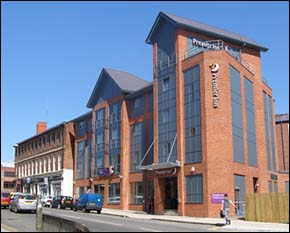The
Black & White
Picture
Place
Memories of the
Royalty
Theatre On to parts 2 | 3 | 4
Updated October 2016
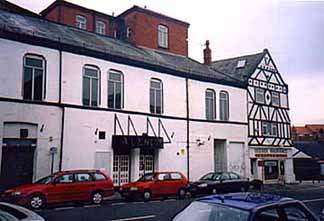  he
Chester
Royalty
Theatre
in
City
Road
first
opened
its
doors
in
1882. It was built on the site of an earlier, wooden building that was used as a makeshift theatre. This apparently started life as a sort of canteen where workmen building the great General Railway Station down the road would be fed and watered. Perhaps they even slept there. It was used to put on plays and circus shows of little artistic merit by groups such as Madame Beatrice's Frou Frou Company. Originally called, for unknown reasons, The Oxford Music Hall, it soon changed its name to The Prince of Wales. he
Chester
Royalty
Theatre
in
City
Road
first
opened
its
doors
in
1882. It was built on the site of an earlier, wooden building that was used as a makeshift theatre. This apparently started life as a sort of canteen where workmen building the great General Railway Station down the road would be fed and watered. Perhaps they even slept there. It was used to put on plays and circus shows of little artistic merit by groups such as Madame Beatrice's Frou Frou Company. Originally called, for unknown reasons, The Oxford Music Hall, it soon changed its name to The Prince of Wales.
Eventually, the wooden structure was replaced with a purpose built brick, 2,000-seat building called The New Royalty Theatre which was built by Bleakley and Son of Birkenhead. City Road itself, linking the new railway station with Foregate Street, had itself only been laid out just over 20 years earlier. The new theatre's street adress, incidentally, was 20-24 City Road.
For a century, the Royalty became a favourite place of family entertainment and must hold many happy memories for generations of Cestrians, let alone those who regularly travelled to be entertained here from further afield.
The first show to be given on the 27-foot stage was a version of Aladdin written by the first stage manager, John Bannister. The pantomime was advertised to open on December 23rd but the building was not ready- it finally opened to the public on Boxing Day, December 26th 1882. See the local press advertisment for the event here.
The opening night audience was treated to the following prologue, recited by John Bannister and written by one John Boddington, who was a member of staff at the Chester Chronicle. (The prologue was included in an article ‘Opening of the New Royalty Theatre’ published by the Chron on 30th December 1882)...
"Halloa ! What’s this? Why, here’s an alteration.
Is this the theatre by the General Station
Where Sheridan so bravely fought of old
To shield the Drama from the winter’s cold ?
‘Tis not a dream- result of indigestion-
Or Fairy palace- that’s quite out of question.
No! No! This chaste interior is real,
Of genius and art the home ideal.
The architect and artist have been here,
And each wrought wonders in his several sphere.
And now you’ll want to know who ‘twas that made ‘em.
Do all I’ve said; and who it was that paid ‘em.
Of couse I might inform you ‘twas a sprite!
But then you tell me ‘Walker!’ You’re quite right.
‘Twas Walker- Carter- Chalton hand in hand;
They’re joint proprietors you understand;
They found a way, by dint of right good will,
And didn’t wait for an improvement bill.
Dull, humdrum, sluggish, “melancholy, slow,”
Describes in numbers of the proper flow
|
The sad condition of our ancient Chester
Minus the theatre. And so just to test her
And see if she’ll support the regular Drama
We’ll presently unfold a panorama
Of human life in every rank and state,
To fire the fancy, and to elevate
The people’s notions; to make rational
And gen’rous their views; and still we’ll fashion all
Our entertainment on this solid fact –
That man’s a Laughing being – and the act
Shows he’s a sense of humour, which at least is
A proof that he’s superior to the “beasties.”
‘Tis certain too, as five and five are ten,
That mirth is the best medicine of men.
“Throw physic to the dogs,” and come to us,
And whilst, dear public, we must all confess
“Tis not in mortals to command success,”
We’ll strive to gain it; your applause we court
And hope you’ll give the Royalty support". |
The interior was designed in the Elizabethan and Queen Anne styles and had two ornate wooden balconies shaped in swan's neck curves. Two statues graced the side walls, one represented music (illustrated left), the other drama (below).
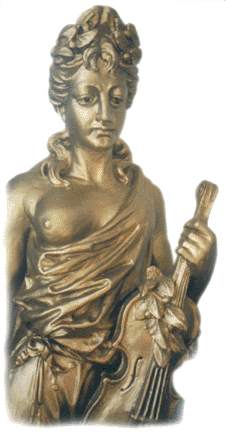 The partnership of Walker, Charlton and Carter were the first owners; in later years, James W 'Jas' Carter became the sole owner. He was running the place when films were first shown in February 1898- these were described at the time as "the greatest living pictures ever seen". See the advertisment that appeared in the local press at the time here... The partnership of Walker, Charlton and Carter were the first owners; in later years, James W 'Jas' Carter became the sole owner. He was running the place when films were first shown in February 1898- these were described at the time as "the greatest living pictures ever seen". See the advertisment that appeared in the local press at the time here...
In 1898 also, Mr Carter (who was also a member of the City Council) became enbroiled in a local religious dispute: in that year, one Miss Nessie Brown announced that she had decided to erect
a memorial to the Protestant cleric George Marsh, who was burned at the stake on Gallows Hill, Boughton in 1555. When news of the plan spread, a furore ensued. There was a considerable number of
Catholics in the city and they staged a series of vehement protests. In those days pantomimes were not solely for
the innocent entertainment of young children, but were also used as vehicles
for the public airing of local (much missed!) political satire. Thus, in his Christmas Pantomime
in 1898 were delivered the lines,
"Something happened many years ago,
To harp on which stirs strife and animosity.
The folks liked not this fuss about a martyr
And showed their sense by plumping straight for Carter".
Despite all the fuss, the erection of the memorial received
the sanction of the City Council and was duly erected on the site of the old stake and gallows where it remains to be seen today.
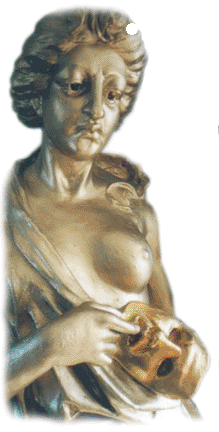 The Royalty for
long
attracted
many
of
the
music
hall
greats
including
Marie
Lloyd,
Sir Harry
Lauder,
Florrie
Ford
and
Sandy
Powell.
The celebrated actor Henry Irvine performed also there. The Royalty for
long
attracted
many
of
the
music
hall
greats
including
Marie
Lloyd,
Sir Harry
Lauder,
Florrie
Ford
and
Sandy
Powell.
The celebrated actor Henry Irvine performed also there.
In December 1915, a fatal accident occured on stage- a Japanes acrobatic troupe, the Mikado Family, were performing their act when 23-year-old Ishiao Ishimura failed to complete a somersault and landed on the stage on the back of his neck. After first aid was given he was transferred to the Chester Royal Infirmary, where sadly he died the following day. Poor Ishiao was laid to rest "far from the bones of his ancestors", in Overleigh Cemetery, where his grave may still be seen, its inscription in both Japanese and English.
In 1905, Mr Carter sold out to the great promoter and impresario Milton Bode (1860-1938), together with partners Edward Compton and Chester businessman Lawrence Booth. Managers in this time included Mr McKim, Mr Andrews, Mr Fontaine and Mr H. Norcott.
Bode purchased the adjoining site on which to build a vast Hippodrome capable of accommodating 4000 people. The project received great opposition, principally from parsons & publicans so he erected the Grosvenor Skating Rink instead and one of his managers, Mr H Norcott became manager of this. By 1922 Bode had become sole owner of the Royalty. Ten years later, in 1932, he sold it outright to Mr Edmund Keyes, who was born and brought up in Chester and was a well known businessman, active in city life who became Sheriff, Alderman and later Lord Mayor. In 1961, following her father's death, Miss Ursula Keyes took over. Miss Keyes was was not just interested in the theatre for, during her lifetime she supported innumerable charities and set up a charitable trust to supporting the medical needs of the local community.
Later in the 1960s, "Chester's Mr Show Biz" Dennis Critchley became the Royalty's manager. In 1946 he had appeared in the Royal Command Performance assisting Nat Mills & Bobbie, one of the star acts of that year. Being good at dialects and an excellent mimic he progressed to become an entertainer/comedy actor playing various roles in revue. Later on he became a solo impressionist performer.
In 1952 he became the assistant manager of the Queen's Theatre, Blackpool and in 1956 was appointed Manager of the Royal Pavilion Repertory Theatre, also in Blackpool.
Then, in 1957 he took over the management of the Royalty Theatre, Chester, where he became a Director and General Manager. He was responsible for Production and Direction of the theatres' own plays, shows and pantomimes. He also controlled the booking of all touring productions which appeared.
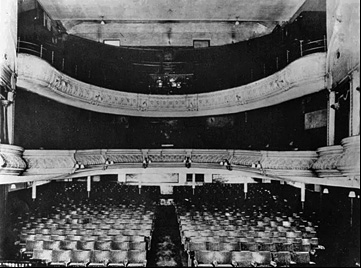 Russ Abbott thanked him personally for teaching him the rudiments of comedy presentation and timing and on his This is your Life in 1997. Russ Abbott thanked him personally for teaching him the rudiments of comedy presentation and timing and on his This is your Life in 1997.
In 1963 he started to write and direct pantomimes and summer shows all over the country for independent managements. His pantomimes appeared at most of Britain's major theatres including the Theatre Royal, Nottingham, the Opera House, Belfast, The Alhambra Theatre, Bradford, to name but a few. He did eight consecutive years of pantomime at the Empire Theatre in Liverpool and seven years at the charming MacRoberts Arts Centre Theatre at the University of Stirling in Scotland. His Summer Shows played all the top holiday venues including Blackpool, Yarmouth, Bournemouth.
During this time, Dennis directed such stars as Harry H Corbet, Les Dawson, Cilla Black, Frank Carson, Mollie Sugden, Nick Berry, Suzi Quatro, Mike Reid, Helen Shapiro, Kathy Kirby Cannon & Ball, Freddie & The Dreamers (favourites in pantomime), Lonnie Donegen, Gerry and the Pacemakers, Rod Hull & Emu, Keith Harris and Orville, Roy Hudd, Melvyn Hayes, Alfred Marks, Dana, Ted Rogers, Peggy Mount, Clive Dunn and Amanda Barrie and many others.
During
the
1950s
and
60s,
many
variety
stars
such
as
Ken
Dodd, Jimmy Young,
Harry
Worth, Frankie Vaughan and Helen Shapiro (aged 14)
performed
at the Royalty,
to
be
followed
by
'pop'
singers and groups
including
Tony Christie, Alma Cogan- 'the girl with a giggle in her voice', Herman's Hermits, the
Rolling
Stones (18th April 1964), Gerry and the Pacemakers
and
the Beatles (they appeared here together 15th May 1963).
The Beatles only played the Royalty once but made more regular Chester appearances at the Riverpark Ballroom opposite the City Baths in Union Street (sadly demolished in 1963 and now the site of a bank's offices). They appeared there five times in 1962, each time on a Thursday: 16th August- the day poor Pete Best was sacked (and didn't turn up for the show, unsurprisingly), 23rd August- also the day John and Cynthia got married!- 30th August, 6th September and 13th September.
(While
the
Fab
Four
were
here
in
1963,
they
heard
tales
of
a
cottage
on
the
banks
of
the
River
Dee
near
the Grosvenor
Bridge,
bearing
the
intriguing
name
of
'Nowhere'.
John
Lennon
was
so
fascinated
he
visited
the
house
to
see
if
it
was
true-
and
later
wrote
a
song,
featured
in Yellow
Submarine, entitled
Nowhere
Man...
John,
incidentally,
had
another
Chester
connection,
for
his
maternal
grandmother,
Annie
Jane
Milward,
was
born
at
the
ancient Bear
and
Billet
Inn in
Lower
Bridge
Street,
in
1873).
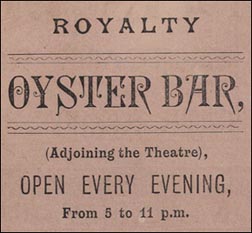 In 1957, builder Frank White undertook extensive structural alterations to the theatre; cantilever-type balconies replaced the older designs with their ornate plasterwork and pillars were removed to improve visibility. Boxes at each side of the stage were also done away with at this time. Our photograph below shows the theatre's interior as it appeared before the alterations, in the early 1950s. In 1957, builder Frank White undertook extensive structural alterations to the theatre; cantilever-type balconies replaced the older designs with their ornate plasterwork and pillars were removed to improve visibility. Boxes at each side of the stage were also done away with at this time. Our photograph below shows the theatre's interior as it appeared before the alterations, in the early 1950s.
Meet Mr Callaghan was the first production to be performed in the refurbished hall. This was opened on 8th July, 1957 by the theatre historian W. McQueen Pope.
Because
of
declining
audience
numbers, allegedly
due
to
the
rising
popularity
of
cinema
and
then
of
television,
the
old theatre
was
forced
to
close
in
1966
after
a continuous
run
of
84
years. The problem was that the Royalty had always operated without subsidy, unlike the (soon, in its turn, to be demolished) Gateway Theatre, which opened in 1968 and has always been supported by grants from the Arts Council, North West Arts Association and Chester City Council. Ironically, the last pantomime to show there was Aladdin- which had been its first, back in 1882. It starred the then-famous duo of Miki and Griff.
The
ground
floor
became
a
'chicken
in
a
basket'
cabaret
club known as The Theatre Royalty Club,
and then, changing hands several times,
was
used
successively
for
bingo,
wrestling
and
as
an
indoor
skateboard
park
before
becoming
a disco known as the Warren Club (opened 3oth August 1965). It's final use was as the
home
of
the popular Alchemy nightclub-
still in
situ when
these
photographs
were
taken
in
April
2001.
Through
all
the
changes,
the
decor
and
fittings
in
the
upper
sections
of
the
old
Victorian
theatre,
such
as
the
statues
illustrated here,
remained
undisturbed
and
intact.
Nontheless, the resplendent gold and scarlet finery of the interior was torn out during successive refits, including some fine oil paintings of Chester's bridges which once graced the auditorium's rear wall.
In
1986,
Chester
City
Council's Conservation
Review
Study had
recommended
the
development
of
the
run-down Royalty site "preferably
retaining
the
theatre
auditorium" but,
by fifteen
years
on, May
2001,
the greed and stupidity we have come to expect once again prevailed, and it
was
announced
that
councillors
had
given
the
go-ahead
for
the
building
to
be
entirely demolished and
replaced
with
two
restaurants,
24
'luxury' apartments
and
a
car
park.
The
plans
for
this
new
development
in
the
city
centre
conservation
area
were
described
by
the Chester
Civic
Trust as "ill-mannered
and
profoundly
unimaginative...
it
is
too
tall,
too
bland
and
altogether
unworthy".
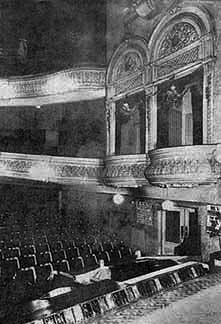 For
those
of
you
who
would
like
to
know
more
of
the
golden
days
of
the
Music
Hall,
we
strongly
recommend
you
read J.
B.
Priestley's wonderful
and
evocative
novel Lost
Empires-
published
in
1965 but,
in
our
experience,
still
easily
to
be
found
in
second
hand
bookshops. For
those
of
you
who
would
like
to
know
more
of
the
golden
days
of
the
Music
Hall,
we
strongly
recommend
you
read J.
B.
Priestley's wonderful
and
evocative
novel Lost
Empires-
published
in
1965 but,
in
our
experience,
still
easily
to
be
found
in
second
hand
bookshops.
We
will
be
bringing
you
more
of
the
history
of
the
Royalty
and
further
details-
hopefully
including
some
'artists
impressions'-
of
the
new luxury apartments
as
soon
as
we
get
them. Can't wait.
Chester, incidentally,
also once
boasted
another
music
hall, cinema
and
theatre,
situated
near
the
Cathedral
in
the
14th
century
Chapel
of
St. Nicolas,
which
still
exists
although
now
utilised
as
commercial
premises.
Learn a little
about
it here and also in our brief history of the Chester cinema here....
Left: The Royalty as it appeared in the early 1950s, before extensive alterations were undertaken- the balconies were altered and the ornate boxes removed entirely.
15th February 2001: Sadly, demolition of the Royalty started this week- and this letter from Paul Crofts of Saughall appeared in the local press:
"Many people, myself included, are sorry to see another part of the city's heritage make way for yet more apartments and restaurants. Any battle to save the theatre would have been lost before it could begin because of the state the building is in. (How could we save this building when we live in a city that recently allowed a courthouse to be built over part of its Roman amphitheatre?)
A few weeks ago I spoke to a very helpful gentleman at the city council's conservation department who assured me that he had visited the theatre last year with a view to getting the building listed.
This was not possible because there was very little of the original interior remaining. The only pieces worth salvaging were some original plaster mouldings and the two statues from either side of the proscenium arch (illustrated above).
Having seen some photographs of these in the local press some time ago, I was concerned that if these items were still intact inside the building, they would soon be lost forever as the demolition crew would rip everything out and throw them into a skip.
I was able to speak to the building's site manager who told me that only a week before, he had been approached by a gentlemen who wanted to rescue these very items amongst others from the theatre for his private collection.
I have since been in contact with this gentleman and what a joy it was to learn that he has rescued a vast collection of bits and pieces not only from the Royalty, but also from our long-gone picture houses too.
His collection includes many photographs of the interiors of these once great entertainment palaces. We must also not forget that last year Dennis Critchley's collection of posters from the Royalty was on display at the Grosvenor Museum.
Later this year an exhibition is to take place within Chester History and Heritage at St Michael's Church featuring photographs and memorabilia of the cinemas and the other places of entertainment.
Although I am far too young to remember the Royalty as it was (I'm only 30), I along with many other people, do care about our heritage. Many people have very fond memories of the Royalty Theatre and it is good that some small parts of it at least have been salvaged". |
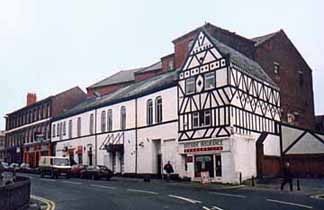
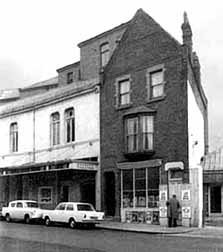
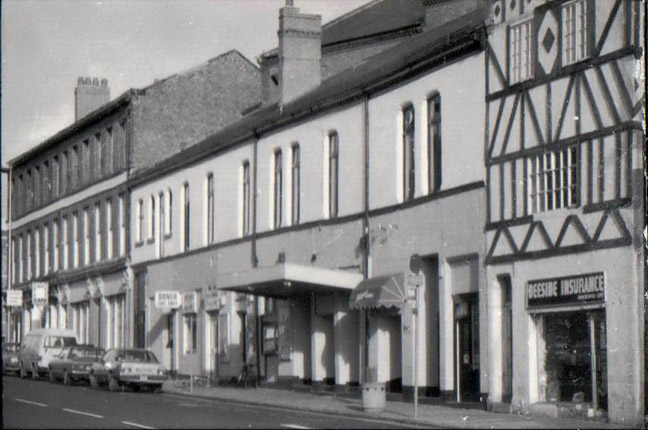
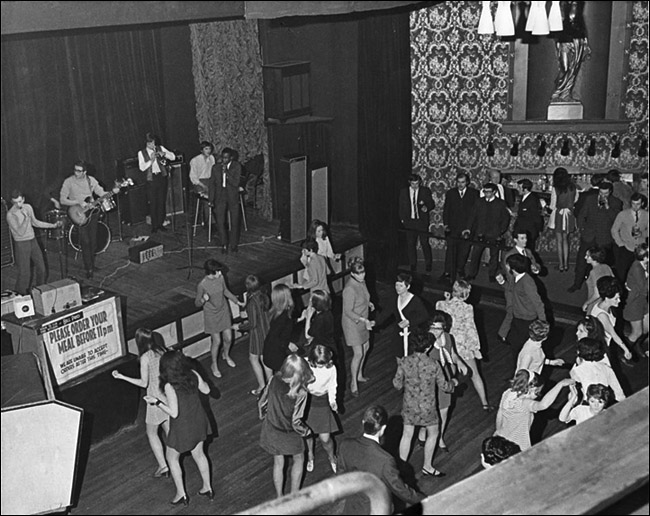
 "If there ever was a perfect place for nightlife then it was Alchemy.
"If there ever was a perfect place for nightlife then it was Alchemy. 


 The partnership of Walker, Charlton and Carter were the first owners; in later years, James W 'Jas' Carter became the sole owner. He was running the place when films were first shown in February 1898- these were described at the time as "the greatest living pictures ever seen". See the advertisment that appeared in the local press at the time
The partnership of Walker, Charlton and Carter were the first owners; in later years, James W 'Jas' Carter became the sole owner. He was running the place when films were first shown in February 1898- these were described at the time as "the greatest living pictures ever seen". See the advertisment that appeared in the local press at the time  The Royalty for
long
attracted
many
of
the
music
hall
greats
including
Marie
Lloyd,
Sir Harry
Lauder,
Florrie
Ford
and
Sandy
Powell.
The celebrated actor Henry Irvine performed also there.
The Royalty for
long
attracted
many
of
the
music
hall
greats
including
Marie
Lloyd,
Sir Harry
Lauder,
Florrie
Ford
and
Sandy
Powell.
The celebrated actor Henry Irvine performed also there.  Russ Abbott thanked him personally for teaching him the rudiments of comedy presentation and timing and on his This is your Life in 1997.
Russ Abbott thanked him personally for teaching him the rudiments of comedy presentation and timing and on his This is your Life in 1997. In 1957, builder Frank White undertook extensive structural alterations to the theatre; cantilever-type balconies replaced the older designs with their ornate plasterwork and pillars were removed to improve visibility. Boxes at each side of the stage were also done away with at this time. Our photograph below shows the theatre's interior as it appeared before the alterations, in the early 1950s.
In 1957, builder Frank White undertook extensive structural alterations to the theatre; cantilever-type balconies replaced the older designs with their ornate plasterwork and pillars were removed to improve visibility. Boxes at each side of the stage were also done away with at this time. Our photograph below shows the theatre's interior as it appeared before the alterations, in the early 1950s.  For
those
of
you
who
would
like
to
know
more
of
the
golden
days
of
the
Music
Hall,
we
strongly
recommend
you
read J.
B.
Priestley's wonderful
and
evocative
novel Lost
Empires-
published
in
1965 but,
in
our
experience,
still
easily
to
be
found
in
second
hand
bookshops.
For
those
of
you
who
would
like
to
know
more
of
the
golden
days
of
the
Music
Hall,
we
strongly
recommend
you
read J.
B.
Priestley's wonderful
and
evocative
novel Lost
Empires-
published
in
1965 but,
in
our
experience,
still
easily
to
be
found
in
second
hand
bookshops. 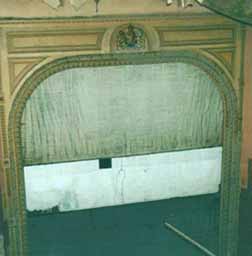 In February 2003, we heard from Ellie King in Canada:
In February 2003, we heard from Ellie King in Canada: